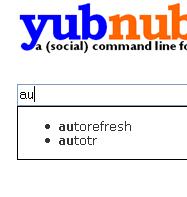YubNub has been around for sometime. I went looking for a Suggest version that would autocomplete common commands. I did a few searches and all I came up with was DashNub which is an OSX Widget. Using script.aculo.us‘s autocomplete code and the XML feed for the YubNub Golden Eggs. My YubNub example now has basic autocomplete. Any YubNub command can be used but autocomplete only works for the 400-500 Golden Eggs.
Note:
– It’s only been tested in Firefox 1.5.01
TODO:
– Test in other browsers
– Add descriptions to each command
– Allow selecting with arrow keys
